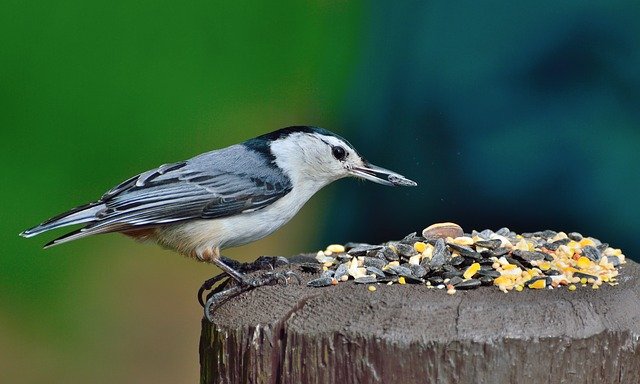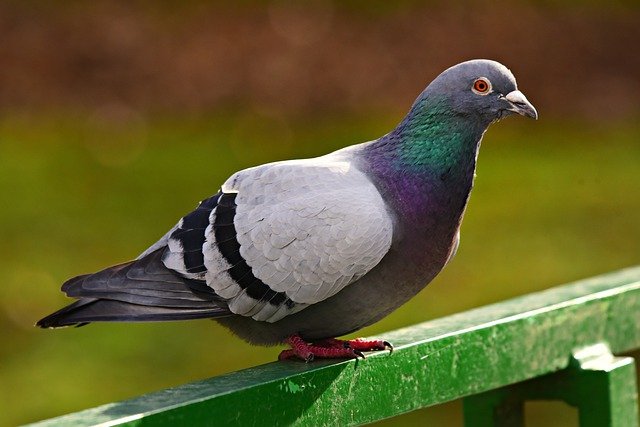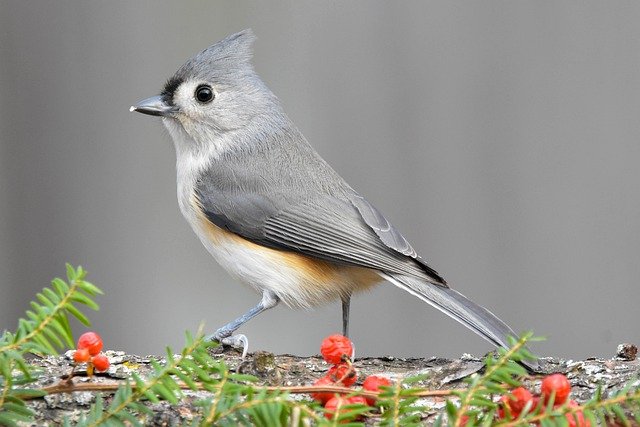If you’re trying to locate gray colored birds within New York the you’ve come to the right article. Here I’ll be going over 7 unique gray birds or birds with elements of gray within their plumage you can look out for within this state the next time you decide to go on a bird watching adventure.
- Sandhill Crane
- American Robin
- White Breasted Nuthatch
- Mourning Dove
- Rock Pigeon
- Black Capped Chickadee
- Tufted Titmouse
7 Gray Birds In New York
1. Sandhill Crane (Grus Canadensis)

- Size: 0.91 – 1.51m
- Weight: 2.72 – 6.34kg
- Wingspan: 1.5 – 1.9m
Sandhill cranes whether the lesser or greater variant are recognised by their gray and brown plumage, their long neck and legs as well as the red spot on their face. They also have a jet black beak. Males are generally bigger than the females whilst the females don’t have any red spots near the eyes and beak.
These cranes tend to spend the majority of their time at open habitats within small bogs, marshes, and prairies. They will also build nests within the same areas they inhabit, but ideally would want the area to be isolated.
Sandhill cranes eat mostly seeds, grains, insects and small animals like worms, mice, small birds, snakes, lizards, frogs and crayfish.
These cranes have a lifespan that extends upto 20 years in the wild.
2. American Robin (Turdus Migratorius)

- Size: 12.5 – 14cm
- Weight: 16 – 22 grams
- Wingspan: 20 – 22cm
American robins are recognised by their gray, black and orange plumage with their heads a darker gray to black color, their back and wings a lighter gray color, their belly and breast an orange color with their beak a bright yellow color. Females are relatively the same in color with a duller color palate as a whole.
These robins can be found around woodland and more open farmland and urban areas. They prefer to live around marshes, fields, forest borders, orchards, hedges, cut-over woods, gardens, urban, suburban, rural yards, and parks.
As for the food American robins eat, it includes insects like beetles, worms, caterpillars, fruits, seeds, suet, crushed peanuts, sunflower hearts and so on.
American robins tend to live for around 2 years in the wild on average whilst they can live upto 5 – 6 years on the upper end of their lifespan.
3. White Breasted Nuthatch (Sitta Carolinensis)

- Size: 13 – 14cm
- Weight: 18 – 30 grams
- Wingspan: 20 – 27cm
White breasted nuthatches are recognised by their gray back, wings and the upper head with white breast feathers. Females look the same as the males with the main difference being their sexual organs.
As for where you would find the white breasted nuthatch, it would be near mature woods and woodland edges, where they’re most commonly located in deciduous stands, including maple, hickory, basswood, oak and are even found in some coniferous forests scattered throughout New York
They mostly consume nuts, seeds and insects, which can include hazelnuts, sunflower seeds, suet and so on.
As for how long white breasted nuthatches live in the wild, it will be for around 2 years with the longest lifespan recorded said to be 12 years.
4. Mourning Dove (Zenaida Macroura)

- Size: 23 – 36cm
- Weight: 96 – 120 grams
- Wingspan: 40 – 50cm
Mourning doves are recognised by their white and gray plumage with the wings being a lighter gray color, whilst the head and body are white and a light brown in color. The way in which you differentiate the males from the females is by the purple patch around the males neck whilst the females don’t have any purple patches.
These birds tend to spend the majority of their time within forest clearings, farmland, suburbs, prairies and deserts. They tend to stay mostly on edge habitats that have both trees and openland within the state of New York.
As for the type of food mourning doves eat, it includes a variety of mixed seed although berries and small arthropods like snails and slugs are part of the diet too with seeds making up about 99% of their diet.
Mourning doves can live upto 31 years in the wild with the average lifespan likely a good bit shorter as a result of the dangerous situations they could encounter in the wild.
5. Rock Pigeon (Columba Livia)

- Size: 30 – 36cm
- Weight: 265 – 380 grams
- Wingspan: 50 – 67cm
Rock pigeons are mostly gray with elements of black on their wings and green plus a red hue across their neck. Females are generally smaller in size and also have a flatter head unlike the males who tend to have a more round head shape.
These pigeons spend the majority of their time around urban parks and neighbourhoods, around farms, under highway, railroad bridges as well as near tall rocky cliffs.
In regards to the food rock pigeons eat, they include a variety of seeds, bread crumbs, seed grasses, worms other insects, berries and acorns.
Rock pigeons tend to live for 6 years in the wild when averaged out.
6. Black Capped Chickadee (Poecile Atricapillus)

- Size: 10 – 15cm
- Weight: 10 – 12 grams
- Wingspan: 15 – 20cm
Black capped chickadees are recognised by their mostly white plumage from breast to tail with grays wings, black throat and upper head. Females look very similar to the males with the main difference being their sexual organs.
Chickadees will spend their time within open woods and forest edge, especially where birches or alders grow. They also avoid coniferous forests.
As for what they eat, it mostly consists of insects, fruits, seeds among other berries. A chickadees diet will adapt to its weather where a large portion of diet is insect based in the summer whilst in the winter seeds, fruit and vegetables consists of around 50% of these little birds diet.
Black capped chickadees are known to live for around 2 – 3 years in the wild although the longest recorded lifespan is said to be around 11.5 years.
7. Tufted Titmouse (Baeolophus Bicolor)

- Size: 15 – 17cm
- Weight: 19 – 22 grams
- Wingspan: 23 – 28cm
A tufted titmouse is recognised by their gray wings, tails, head and back, white belly and chest with a bit of orange under the wings, a black beak and mohawk like feathers on the top of their head. Females and males look very much the same.
Tufted titmice tend to spend the majority of their time within deciduous woods or mixed evergreen-deciduous woods, typically in areas with a dense canopy and many tree species. orchards, parks, and suburban areas in lower elevations are where they are most commonly found.
These birds mostly eat sunflower seeds, suet, peanuts, and other seeds, some of whom will go to bird feeders regularly. Insects like beetles and other smaller berries make up a portion of their diet too.
On average tufted titmice tend to live for around 2 years in the wild although, some have even been known to live for 13 years.
Amhil Khan, a dedicated nature enthusiast and the founder of BirdsOfTheWild.com, is a passionate advocate for the captivating world of avian wonders. With a deep-seated curiosity about the intricate lives of birds, Amhil’s journey began as a fascination and has evolved into a mission to inspire others to appreciate and protect these magnificent creatures.
Amhil’s love for birds led to the creation of Birds of the Wild, a platform where his expertise in ornithology, coupled with his captivating storytelling, provides readers with an immersive and educational experience. Through his lens and words, he captures the essence of birds in their natural habitats, offering a glimpse into their behaviors, migrations, and the ecosystems they inhabit.

